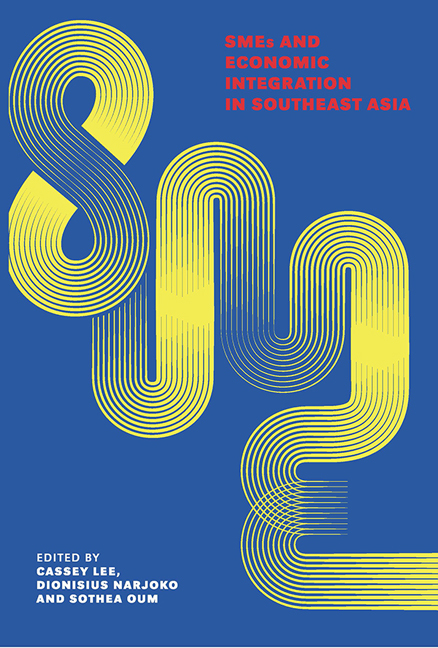Book contents
- Frontmatter
- Contents
- List of Tables
- List of Figures
- About the Contributors
- 1 Introduction
- PART 1 COUNTRY STUDIES
- 2 SME Participation in ASEAN and East Asian Integration: Case of Cambodia
- 3 Indonesian Small and Medium Enterprise Participation in ASEAN Economic Integration
- 4 Lao SME Participation in Regional Economic Integration
- 5 Government Policies, Regional Trading Agreements and Economic Performance of National Electronic Components Small and Medium-sized Enterprises in Malaysia
- 6 Myanmar SMEs’ Participation in ASEAN and East Asian Regional Economic Integration: With a Focus on Food and Apparel Manufacturing
- 7 Philippine SME Participation in ASEAN and East Asian Regional Economic Integration
- 8 Thailand's SME Participation in ASEAN and East Asian Regional Economic Integration
- 9 Vietnam SMEs’ Participation in Regional Economic Integration: Survey Results of Three Manufacturing Sectors
- PART 2 MULTINATIONAL ENTERPRISE STUDIES
- Index
6 - Myanmar SMEs’ Participation in ASEAN and East Asian Regional Economic Integration: With a Focus on Food and Apparel Manufacturing
from PART 1 - COUNTRY STUDIES
Published online by Cambridge University Press: 06 September 2019
- Frontmatter
- Contents
- List of Tables
- List of Figures
- About the Contributors
- 1 Introduction
- PART 1 COUNTRY STUDIES
- 2 SME Participation in ASEAN and East Asian Integration: Case of Cambodia
- 3 Indonesian Small and Medium Enterprise Participation in ASEAN Economic Integration
- 4 Lao SME Participation in Regional Economic Integration
- 5 Government Policies, Regional Trading Agreements and Economic Performance of National Electronic Components Small and Medium-sized Enterprises in Malaysia
- 6 Myanmar SMEs’ Participation in ASEAN and East Asian Regional Economic Integration: With a Focus on Food and Apparel Manufacturing
- 7 Philippine SME Participation in ASEAN and East Asian Regional Economic Integration
- 8 Thailand's SME Participation in ASEAN and East Asian Regional Economic Integration
- 9 Vietnam SMEs’ Participation in Regional Economic Integration: Survey Results of Three Manufacturing Sectors
- PART 2 MULTINATIONAL ENTERPRISE STUDIES
- Index
Summary
Myanmar's Historical and Macroeconomic Context
For decades, Myanmar's economic system has been characterized by central planning and economic isolation, the latter partly self-imposed and partly due to international sanctions that were put in place in response to military rule. Today, however, Myanmar is leaving this past behind and things are changing rapidly. The shift towards a market-oriented economic system actually started in 1988. Back then, a number of reforms were initialized, aiming at liberalizing the economic system, encouraging private sector development, and promoting external trade as well as foreign direct investment. These developments have gained momentum with changes in the political sphere where a transition towards democracy was initiated in the late 2000s with a constitutional referendum in 2008 and multi-party elections in 2010. The international community welcomed these reforms and gradually re-integrated Myanmar.
As a result, today there is widespread agreement that the country has great potential for rapid development in the future, in particular thanks to its vast natural resources, its abundance of (especially young) labour, and its geostrategic location (being a member state of the Association of Southeast Asian Nations (ASEAN) and bordering the two most important and dynamic emerging economies, i.e. China and India). In fact, since Myanmar's leadership adopted a market-oriented system in 1988, the number of private manufacturing firms has increased threefold. At the same time, numerous challenges remain. Neither the economic nor the political transition can be expected to be easy and without hiccups. Myanmar is still one of the poorest country in the region. Its economy is dominated by agriculture, characterized by low levels of productivity, and hamstrung by underdeveloped infrastructural and financial systems. Moreover, despite the lifting of sanctions there is still a long way to go for the country in terms of integrating into regional and international economic systems.
Tables 6.1–6.3 report a number of different macroeconomic statistics that reflect both the positive developments that Myanmar has achieved but also the challenges that were encountered. Table 6.1, for example, shows that Myanmar has seen impressive economic growth. While more recent GDP growth rates did not quite match the two-digit growth rates recorded at the beginning of the millennium, they still remained at high levels and, in fact, accelerated again since 2010 (from about 5 per cent to around 8 per cent per year).
- Type
- Chapter
- Information
- SMEs and Economic Integration in Southeast Asia , pp. 170 - 286Publisher: ISEAS–Yusof Ishak InstitutePrint publication year: 2019



